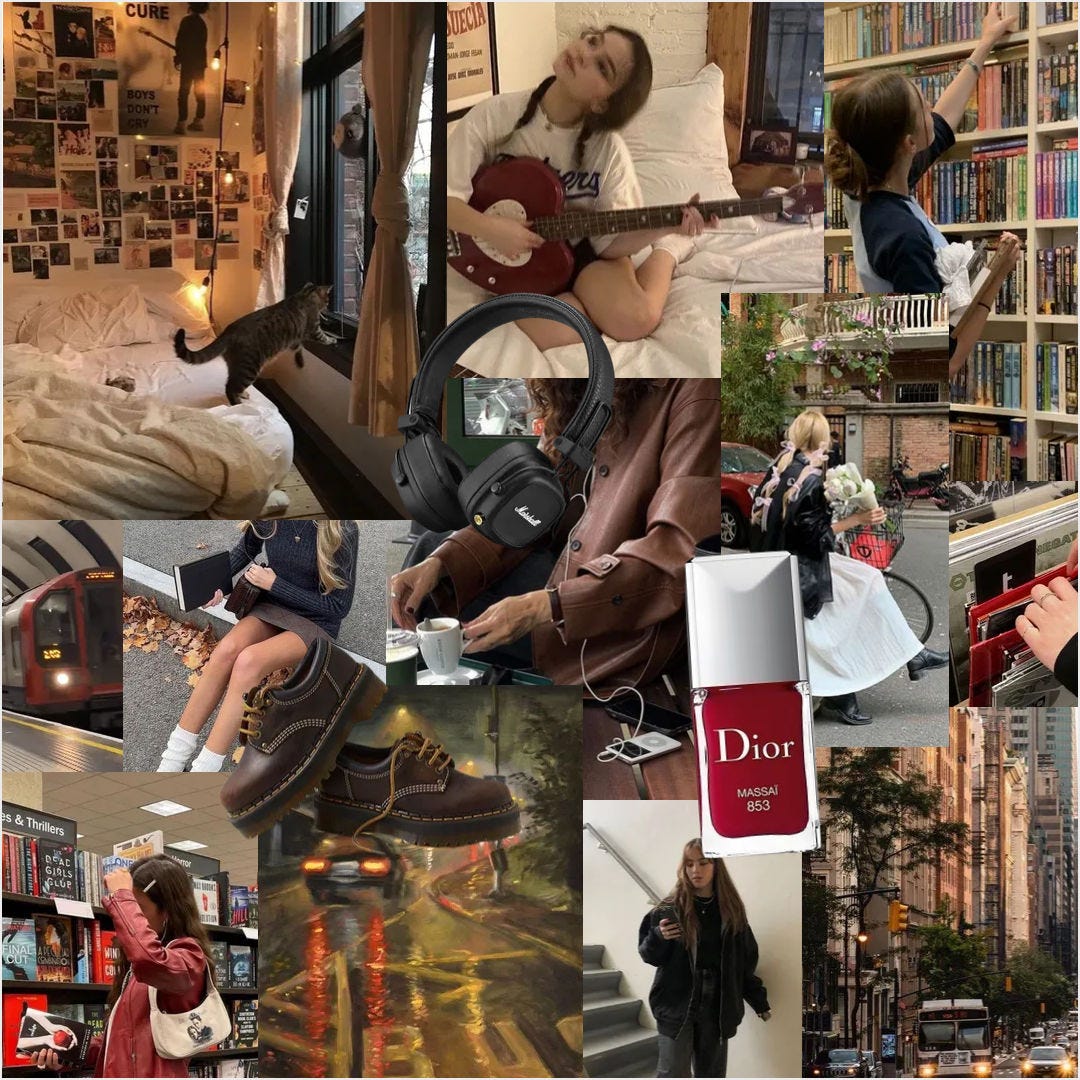on the topic of aesthetic obsession
a short essay about our obsession with aesthetics and self identity
In this, my first ever Substack post, I will be discussing social media’s obsession with aesthetics and self-identity.
Before we start, don’t get me wrong, I find myself participating in the microtrends and overconsumption that will come up in this essay as much as the next person. After all, I do frequent the Pinterest For You page. Here, I simply wanted to analyze why we’re so enamored with self-identity curated by what internet aesthetics we think we fall under and what that means for us.
The term aesthetic, as it is defined by the Oxford Dictionary, means “concerned with beauty or the appreciation of beauty.” However, the original meaning of the word has changed drastically over time. Entering the lexicon sometime in the Eighteenth Century, the first modern interpretation was in the writings of Immanuel Kant. Kant describes our aesthetic experiences as “beauty” (form, order, harmony, and bound dignity) and “sublime” (irrational; too much to take in). But that is only two of Kant’s terms used to describe our aesthetic experiences. Kant also wrote of his theory of “disinterested pleasure” the idea that beauty needs to be detached from utility and one’s survival needs. As soon as beauty is given a purpose or an agenda, there’s a cheapening of it. This distinction reflects the capitalistic nature of the current trend cycle and aesthetic obsession. Again, the interpretation and meanings of aesthetics have varied over time, and I won’t even attempt to unpack all of those variations in this post.
Moving on to the present, aesthetics in the context of social media holds almost an entirely different meaning. Since the pandemic, the concept of internet aesthetics has exploded. You may recall when the cottagecore, indie (I still have that cow mug), Y2K, and e-girl aesthetics dominated what feels like eons ago. Countless aesthetics and subcultures have spawned from the previous ones, creating a never-ending list of crafted identities to choose from. Here are a few recent examples:
Balletcore
Balletcore is characterized by tulle, the color pink, tights, leg warmers, sleek buns, leotards, Miu Miu ballet flats, and Sandy Liang. While researching the balletcore aesthetic, you may also come across screenshots from the films Black Swan and The Red Shoes.
Downtown Girl
Downtown Girl is described as 90s grunge with a Gen Z twist. The aesthetic revolves around the romanticization of living in the downtown area of a city. If you’re looking to adopt this aesthetic, look for band tees, mini skirts, Doc Martens, oversized sweaters, dark red nail polish, vinyl records, and a good pair of headphones.
Coquette
Coquette often spills into balletcore with its hyperfeminine visuals like bows and soft pinks. Unlike the other two, though, Coquette represents a broader tag on social media that is generally associated with Lana Del Rey songs, lace, high waist skirts, pearl necklaces, and Vladimir Nabokov’s Lolita. There are various subcategories within the Coquette aesthetic, such as nymphet, dark nymphet, and dollette. (There is so much more I want to say about this one, but I won’t do it here because that’s not what this is about. Another day, maybe.)
Social media aesthetics are concerned primarily with creating an appearance and shaping the way we are perceived by others. Aesthetics like balletcore, for example, portray a romanticized version of a lived experience. Balletcore, the aesthetic, is said to be so divorced from actual ballet that it has no impact on the art itself. That isn’t to say one can’t develop an interest in ballet through the aesthetic.
Our generation is obsessed with how we’re perceived both online and in real life. Falling perfectly into an aesthetic Pinterest search term can make us feel a sense of validity and belonging. However, social media and aesthetic obsession have skewed our expectations of aesthetics and their accessibility to us.
As referred to in a Reddit post by Pink_Slime_Tenders titled "Obsession with 'aesthetics' kills self expression”
“...it becomes commodified in a mainstream and marketable way to make it less about your own expression and more about fitting into a consumerist box.”
Consumerism is at the forefront of modern aesthetics. To keep up with the rapidly changing trend cycle (even within the aesthetic itself!), you have to keep spending and spending. With attractively named microtrends, like blueberry milk nails and latte makeup popping up weekly, it’s impossible to ignore and not be influenced by them. In short, this is great for capitalism, not for us. There was once a time when trends defined entire decades. Think bell bottoms for the 70s and shoulder pads for the 80s? Since the introduction of social media sites like TikTok, that timeline has reduced to 3 to 5 months max. I am waiting with bated breath to find out what we will recognize as the 2020’s decade-defining trends (And how we’ll even do that).
So, does this mean we should never participate in a trend again and sever all ties from our chosen TikTok aesthetic? Of course not. I don’t wish to punch down on the young people who are most likely to be targeted by the pressure to fit into a social media box. Let’s face it, merely existing at this age is difficult because you’re constantly trying to figure out who you are. Instead, I want to encourage branching out from just one aesthetic and focus on building personal style. Honestly, you could combine every popular aesthetic into one thing. Who’s to stop you?
Resources:
an overview of kant and beauty
social media's obsession with aesthetics and curated identities
https://aesthetics.fandom.com/wiki/Balletcore#Movies







